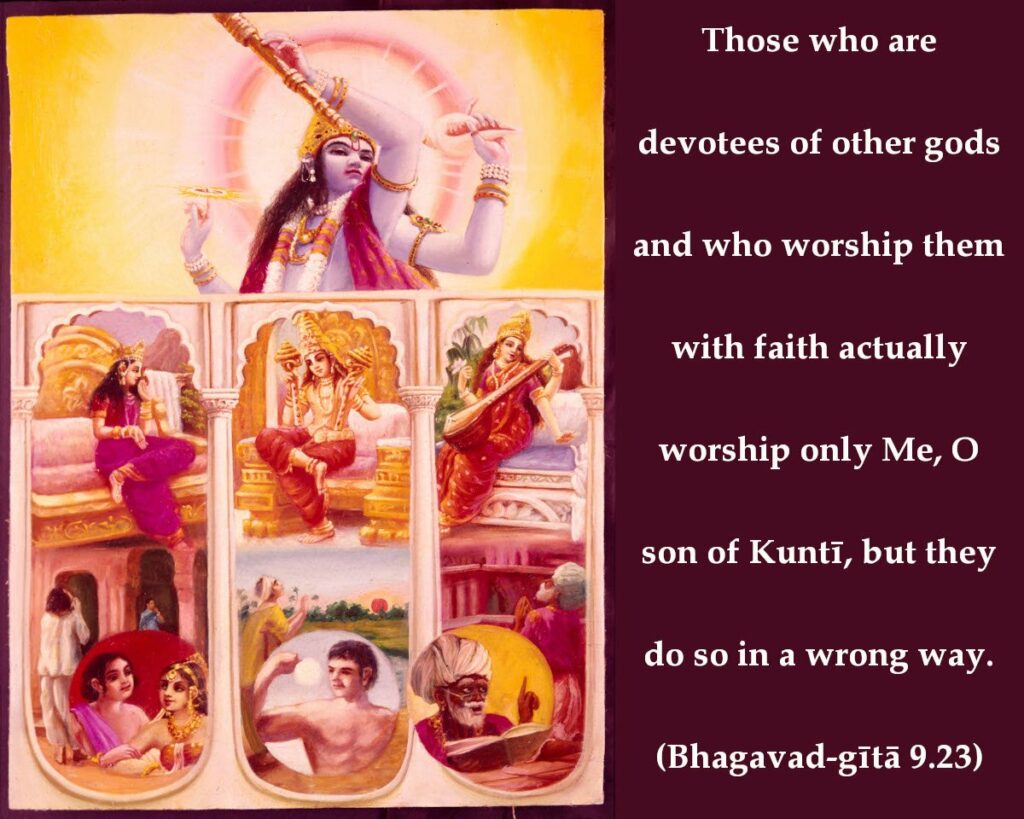येऽप्यन्यदेवता भक्ता यजन्ते श्रद्धयान्विता: |
तेऽपि मामेव कौन्तेय यजन्त्यविधिपूर्वकम् || 23||
ye ’pyanya-devatā-bhaktā yajante śhraddhayānvitāḥ
te ’pi mām eva kaunteya yajantyavidhi-pūrvakam
ye—those who; api—although; anya—other; devatā—celestial gods; bhaktāḥ—devotees; yajante—worship; śhraddhayā anvitāḥ—faithfully; te—they; api—also; mām—Me; eva—only; kaunteya—Arjun, the son of Kunti; yajanti—worship; avidhi-pūrvakam—by the wrong method
Translation:
Even those devotees who, endowed with faith, worship other gods, worship Me alone, Ο son of Kunti, though in a wrong way.
Commentary:
Some devotees worship, not the formless Brahmam but other Gods with name and form. If their devotion is sincere, they in a sense, worship the supreme who is the foundation for all Devas. This form of worship is the wrong method. They are not worshipping the Supreme directly. So there is a difference in the fruits of merit. The various Devas may confer different rewards of health and wealth, children and prosperity in worldly life, but the worship of the Supreme confers the highest reward of Moksha (liberation). Whatever may be the object of worship, faith is essential. With such faith, if the Lord is worshipped the devotee obtains liberation.
Swami Vivekananda Says —
Later on we read what Krishna says, “Even those who worship other deities are really worshipping me.” It is God incarnate whom man is worshipping. Would God be angry if you called Him by the wrong name? He would be no God at all! Can’t you understand that whatever a man has in his own heart is God — even if he worships a stone? What of that![Source]
Sri Ramakrishna Says —
MASTER (to Balaram’s father and the others): “The Bhaktamala is one of the Vaishnava books. It is a fine book. It describes the lives of the various Vaishnava devotees. But it is one-sided. At one place the author found peace of mind only after compelling Bhagavati, the Divine Mother, to take Her initiation according to the Vaishnava discipline.
“Once I spoke highly of Vaishnavcharan to Mathur and persuaded him to invite Vaishnavcharan to his house. Mathur welcomed him with great courtesy. He fed his guest from silver plates. Then do you know what happened? Vaishnav said in front of Mathur, ‘You will achieve nothing whatsoever in spiritual life unless you accept Krishna as your Ideal.’ Mathur was a follower of the Sakta cult and a worshipper of the Divine Mother. At once his face became crimson. I nudged Vaishnavcharan.
“I understand that the Bhagavata also contains some statements like that. I hear that it is said there that trying to cross the ocean of the world without accepting Krishna as the Ideal Deity is like trying to cross a great sea by holding to the tail of a dog. Each sect magnifies its own view.
“The Saktas, too, try to belittle the Vaishnavas. The Vaishnavas say that Krishna alone is the Helmsman to take one across the ocean of the world. The Saktas retort: ‘Oh, yes! We agree to that. Our Divine Mother is the Empress of the Universe. Why should She bother about a ferry-boat? Therefore She has engaged that fellow Krishna for the purpose.’ (All laugh.)
“Besides, how vain people are about their own sects! There are weavers in the villages near Kamarpukur. Many of them are Vaishnavas and like to talk big. They say: ‘Which Vishnu does he worship? The Preserver? Oh, we wouldn’t touch him!’ Or: ‘Which Siva are you talking about? We accept the Atmarama Siva.’ Or again, ‘Please explain to us which Hari you worship.’ They spin their yarn and indulge in talk like that.
“Rati’s mother, Rani Katyayani’s favourite confidante, is a follower of Vaishnavcharan. She is a bigoted Vaishnava. She used to visit me very frequently, and none could outdo her in devotion. One day she noticed me eating the prasad from the Kali temple. Since then I haven’t seen even her shadow.
25.22 Master’s harmony of religions
“He is indeed a real man who has harmonized everything. Most people are one-sided. But I find that all opinions point to the One. All views — the Sakta, the Vaishnava, the Vedanta — have that One for their centre. He who is formless is, again, endowed with form. It is He who appears in different forms. The attributeless Brahman is my Father. God with attributes is my Mother. Whom shall I blame? Whom shall I praise? The two pans of the scales are equally heavy.’
“He who is described in the Vedas is also described in the Tantras and the Puranas. All of them speak about the one Satchidananda. The Nitya and the Lila are the two aspects of the one Reality. It is described in the Vedas as ‘Om Satchidananda Brahman’, in the Tantras as ‘Om Satchidananda Siva’, the ever-pure Siva, and in the Puranas as ‘Om Satchidananda Krishna’. All the scriptures, the Vedas, the Puranas, and the Tantras, speak only of one Satchidananda. It is stated in the Vaishnava scriptures that it is Krishna Himself who has become Kali.” (Source: Gospel of Sri Ramakrishna)
Related Articles:
- O Arjuna! In whatsoever form one seeks Me, I reach him in that form, for all mankind are but following the paths I laid down for them. (BG 4.11)
- Whatever may be the form a devotee seeks to worship with faith— in that form alone I make his faith unwavering. (BG 7.21)
Question: How should man worship God?
Answer: With faith.
Bhagavad Gita: Chapter 9 🔻 (34 Verses)
